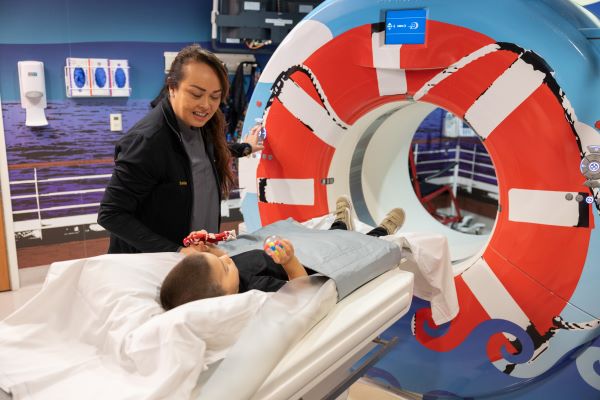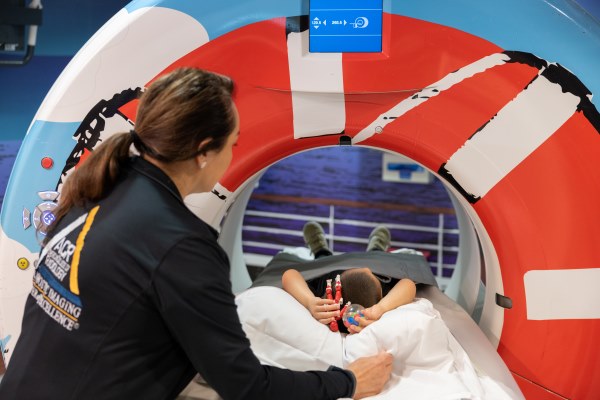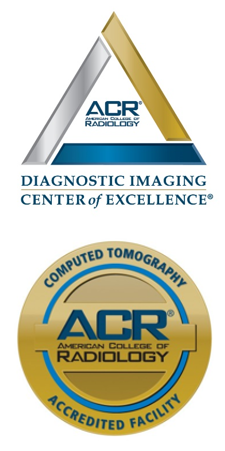CT Scan (Computed Tomography Scan)
A CT scan is a quick and painless test that helps doctors see inside the body using special X-ray equipment and computers. It creates detailed pictures of organs, bones, tissues, and blood vessels. CHOC radiologists use advanced equipment to interpret the CT images. This helps in diagnosing problems or monitoring treatment progress.

When is a CT scan needed?
CT helps diagnose a wide range of conditions due to injury or illness such as:
- Causes of abdominal pain
- Evaluate injury after trauma
- Diagnose and stage cancer
- Monitor response to cancer treatment
- Diagnose and track infectious or inflammatory disorders
- Assists with guidance for biopsies and other procedures
CT can also check blood vessels throughout the body using a special test called an angiogram. With CT, it is possible to retrieve detailed pictures of the heart and tiny heart vessels in children and newborn infants.
What are the different types of CT scans?
CT scans can check many parts of the body. Here are some common exams:
- Abdomen/Pelvis – Used to check the liver, pancreas, kidneys, spleen, intestines, bladder, stomach, appendix, gonadal organs, adrenal glands and lymph nodes
- Chest– Used to see the lungs, heart, major blood vessels, airway passages and ribs
- Head– Helps look at the brain, skull, sinuses and major blood vessels
- Neck– Used to check the lymph nodes, major neck muscles, throat, tonsils, adenoids, thyroid as well as other glands
- Extremities– Used to check bones, blood vessels and even muscle.
3D models can be created as well to using the information from the CT scan to help see the anatomy better.
What type of CT scan machine does CHOC use?
CHOC is proud to offer our patients the very latest in CT technology. Our scanner delivers the lowest radiation dose possible. It scans so quickly, that repeat scans and sedation are rarely needed. In fact, other hospitals have begun transporting newborns to CHOC for imaging because of these capabilities. This state-of-the-art machine is only found in a handful of children’s hospitals throughout the United States.
Our flash CT scan machine:
- Scans the entire body in less than 5 seconds
- Uses a very low dose of radiation while producing high-quality images
- Allows customized scans based on your child’s measurements and symptoms. This makes sure that they get the lowest dose of radiation possible.
Can a CT scan harm my child?

A CT scan is a safe, noninvasive procedure used to diagnose problems inside a patient’s body. There is a low-level of radiation exposure, but the benefit of getting a correct diagnosis outweighs the low risk of harm.
At CHOC, we have received accreditation by the American College of Radiology for MRI, CT, Nuclear Medicine and ultrasound. This means that we meet the highest standard of image quality and safety. Since children are more sensitive to radiation they should have a CT study only if it is needed for making a diagnosis.
What is the preparation for a CT scan?
- Children should wear loose, comfortable clothing without metal and glitter. They can bring a “comfort item” to hold during the scan.
- Depending on the scan ordered by the physician, the child may not eat or drink before the procedure.
- Lab tests may need to be done before the day of the scan.
- For some types of CT scans your child might need a contrast solution (IV, oral or both) to help see the area of interest.
- Our radiology team will contact you one to two days before the appointment with information about your child’s exam.
Will my child need contrast?
Some children may need contrast for their exam. Your child’s doctor orders contrast. If contrast is necessary, our team will provide instructions on how to prepare for your child’s test.
- They might get contrast through an intravenous line (IV) placed in their hand or arm. Placing the IV will feel like a quick pinprick, but CHOC can offer a numbing medicine to help. We also have a team of specially trained nurses who can help place IVs. The IV contrast is very safe. The child may feel a sensation like they have to urinate or a warm flushed sensation after the dye goes into the vein. This is a normal feeling and will subside quickly.
- If your doctor orders oral contrast your child will be required to drink a solution before the exam. Some kids don’t like the taste, but it can be flavored to make it taste better.
In some cases, both oral and intravenous contrast is needed.
Infants and small children may need anesthesia if they cannot hold still long enough for the exam or if special breathing instructions are needed for the exam.
What if my child gets scared?
While a CT scan is non-invasive and painless, we understand that these machines can be frightening to your child. Our child life specialists help children of all ages feel comfortable and safe. We even have a toy-sized CT machine that can help teach them about the test beforehand. Learn more about our child life specialists and distraction techniques.
How is the CT scan performed?
CT scans are painless, fast, and easy. First, it begins with the child lying down on a narrow table. The table slides in and out of a doughnut-shaped hole in the center of the CT scanner. Straps and pillows may be necessary to help the child stay still for the exam.
The scan itself only takes a few minutes to complete. Your child should stay still during the scan since movement will affect the quality of the images. Our scanner is fast enough to scan most children successfully. In special cases, anesthesia may be necessary for children who cannot hold still.
What happens after the procedure?
In most cases, the child should be able to resume normal activities immediately after the procedure, unless the child’s doctor has instructed otherwise. Children who received anesthesia will rest in the recovery area until the medication wears off. Children who received contrast should drink plenty of fluids to help flush the contrast dye out of the body.
The doctor who ordered your child’s scan will receive a report. Please contact the doctor who ordered the scan for the results.
Why Choose CHOC?

- CHOC has been designated a Diagnostic Imaging Center of Excellence® (DICOE) by the American College of Radiology (ACR) for best-quality imaging practices and diagnostic care.
- CHOC uses only board-certified pediatric radiologists and specially trained pediatric radiology technologists, nurses and child life specialists.
- All radiology staff undergo age-specific training annually to learn how to work and communicate with children of varying ages.
- We are only one of a few medical centers in the country to have child life specialists working in a dedicated pediatric radiology and imaging department.
Meet Our Computed Tomography Director

Holmes, W. Nathan MD
Specialty:
Radiology
Appointments: 888-770-2462
Dr. Holmes is certified by the American Board of Radiology and treats kids and teens at CHOC in Orange County.












